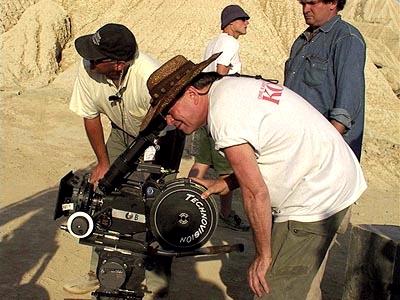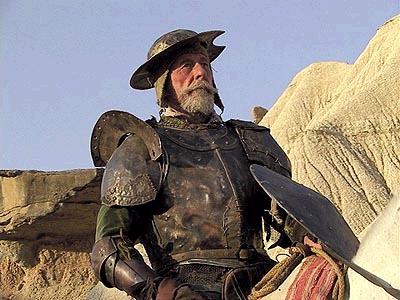

Where is the justice in this world when Terry Gilliam has a dream to make his adaptation of Don Quixote, which ends in abject failure, and Roberto Benigni's dream to make Pinocchio succeeds, only it is a failure in itself? Gilliam is the creative genius behind Twelve Monkeys, Fear and Loathing in Las Vegas, The Fisher King, The Adventures of Baron Munchausen, Time Bandits, and the Monty Python movies. His decade long dream was to mount a production of Don Quixote, and he wanted Keith Fulton and Louise Pepe (Moments of Doubt) to document it. Fulton and Pepe were the men behind The Hamster Factor and Other Tales of Twelve Monkeys, which was a documentary they did for Gilliam that he enjoyed. They started filming a documentary on the making of Gilliam's The Man Who Killed Don Quixote and ended up with a documentary about a shoot where everything that could go wrong did.
Lost in La Mancha is enjoyable on two levels. First, one can see what happens during the initial production stages of a movie. Specifically, one can see Gilliam's mind at work, taking things out of his head and making them a reality. Second, one can see how events out of a director's control can completely ruin something that had the potential to be very good. Something similar happened to Gilliam on the set of Munchausen, as the specter of the film hung over his head constantly. He could not make the movie he wanted with the budget he had. Gilliam is a perfectionist who gained a reputation as somebody who could be difficult to work with. For Quixote, he soon found himself in a similar situation. The production was $32 million, but was financed solely with European money. While in Hollywood this is a meager sum, but this amount made it one of the most expensive European productions ever.
For Quixote, Gilliam wanted French actor Jean Rochefort (The Closet, Honolulu Baby), Johnny Depp (From Hell, Blow) as the Sancho Panza character, and Vanessa Paradis (The Girl on the Bridge, Half a Chance) as the female lead, but was having an extremely hard time getting them to Spain for rehearsal. When Rochefort, who learned English for the role, finally arrived, he had to fly back to France because of medical problems. Gilliam also learned that he was filming next to a NATO air base, and then ran into a freak rainstorm that washed the gear away. All these problems compounded and proved too much and The Man Who Killed Don Quixote was shut down. Still, the most fascinating aspect of Lost in La Mancha is watching Gilliam and crew press forward while slowly realizing their efforts are futile.
It is devastating watching Gilliam realize the death of his dream. At one point, somebody compares him to Quixote, and it is an apt description. This movie is his impossible dream (Orson Welles also tried to make a Quixote movie). Even when the production is collapsing around him, he will still giggle like a child when Rochefort and Depp recite their lines. Because of Gilliam's trust of Fulton and Pepe, they were able to capture some incredible moments on film. They show the producers discussing whether to fire the assistant director, and tense moments and frustrations between Gilliam and other crew members. The one bad thing about Lost in La Mancha is that viewers will not be able to see Gilliam's vision come to life (at least not in the near future). Gilliam's movies are always interesting and imaginative, and The Man Who Killed Don Quixote looked no different.